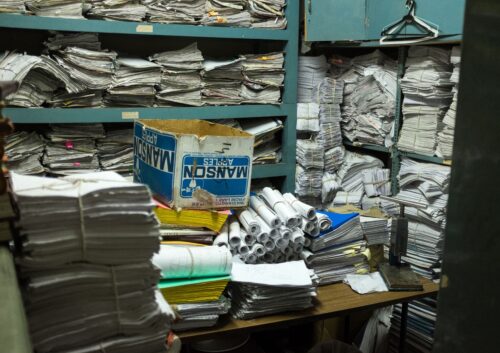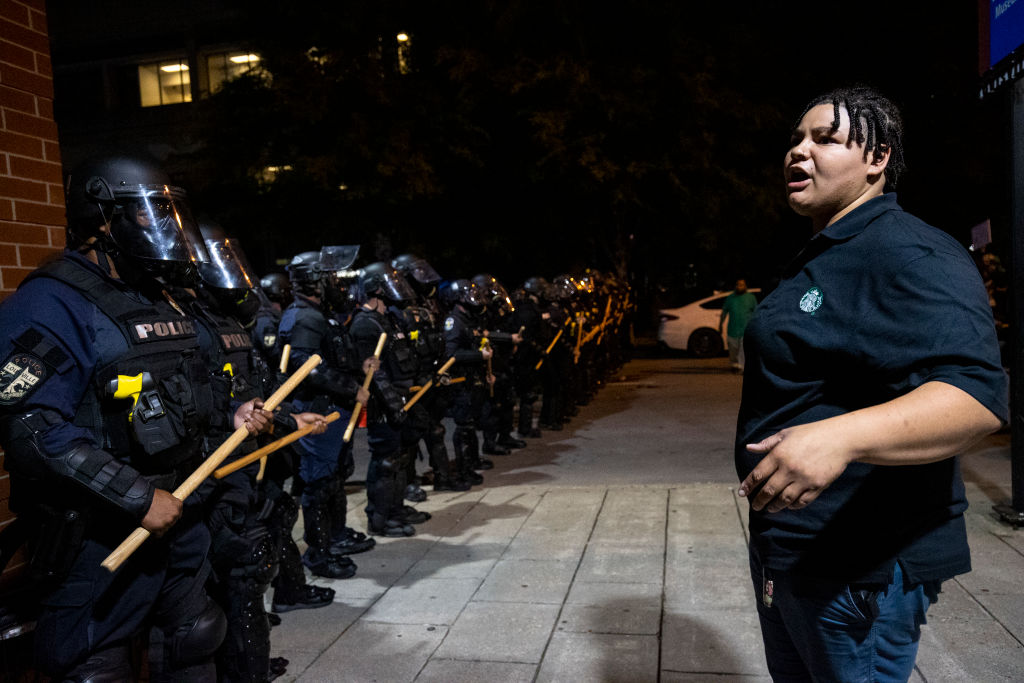Can Protestors Humanize the Police?
Watch this video. In it, a group of young Black Lives Matter protestors in Charleston, South Carolina, take a knee, facing a line of police in riot gear. One young African American man, Givionne “Gee” Jordan Jr., calls out imploringly to the officers, sometimes crying as he speaks.
“I feel the pain of black people. I feel the pain of white people. I feel the pain of innocent cops. … You are not my enemy. … You are my family, and I love you. … I want to understand y’all.”
As he speaks, the police stand inscrutably silent in their reflective face shields, batons at the ready. Then a group of police, their faces hidden behind gas masks, break the line. Acting wordlessly, they grab the young man who has been telling them he loves them and lead him away. They arrest no one else.
His crime, it seems, was speaking to the police.
The First Amendment to the Constitution ties speech to protest and enshrines it as a fundamental right of free Americans; it forbids “abridging the freedom of speech, or of the press; or the right of the people peaceably to assemble, and to petition the Government for a redress of grievances.”
Protests are awash in speech acts. Speakers exhort the crowd, and participants march with signs carrying messages that are like micro-tweets: “Silence is a virus,” “Racism has killed more people than COVID-19,” “If you think these masks make it hard to breathe, try being black in America,” “Am I next?,” “The color of my skin should not put a target on my back,” and “Who watches the watchmen?” are some from recent days.
Protestors’ speech acts are addressed to other protestors and to the general public, but in the protests ignited by the police killing of George Floyd, they are sometimes also, like Jordan’s, directly addressed to the police. On May 31, I watched a protestor outside the White House move along the fence dividing Lafayette Park, calling out to the police one after another, “Did you check in with your black colleagues to see how they feel?” (He got no replies.) A protestor in Dayton, Ohio, used a bullhorn to ask the police, “Raise your hands if you are here to protect us and stand with us?” Other protestors have called out, “Do you believe black lives matter?” The Washington Post reported on one African American 18-year-old who pled with a black Secret Service officer, asking for a sign of solidarity: “One fist. Is that too much to ask for? Do you have no heart? … Please, one fist!”
In such moments, protestors seek to undermine police unity and discipline, but also to humanize police by reaching out to them as fellow citizens. More often than not, they are met with a stony, expressionless silence—sometimes accompanied by the use of force, as shown in the video that went viral of a CNN crew being arrested as they broadcast live, even as their requests to know why were ignored. And, of course, there is the incident that started it all, where four Minneapolis policemen ignored George Floyd’s pleas that he could not breathe, as bystanders called out: “Get off of him. What is wrong with you all? Check his pulse.”
Police silence in such moments is also a communicative act. It says: We are not accountable to you.
I recently took a class in which most of the instructors and my fellow students were police officers. My classmates were decent people, and I do not want to minimize the danger and difficulty of a job that can lead to death or injury without warning. But I was troubled by the way their approach to policing was permeated by the mindset of counterinsurgency (perhaps unsurprising given how many are military veterans). In this mindset, populations that are seen as inherently prone to criminality are kept under surveillance, unrest is quelled, and “bad guys” are detected and removed from circulation with little regard to the circumstances.
It is clear that the relationship between U.S. police and minority communities is broken. This is because of what former President George W. Bush characterized as “systemic racism in our society” and decisions by politicians over the last four decades that have given the U.S. the highest incarceration rate in the world. But it is also because of shifting police practices that have embrittled the relationship between cops and those they police.
Beat cops walking the streets have been replaced by cops in cars, who are therefore more distanced from local communities, and these cops are increasingly equipped with military hand-me-down equipment thanks to the government’s 1033 program to transfer surplus military equipment to the police. Between 1990 and 2017, US$6 billion of equipment was transferred from the Department of Defense to domestic law enforcement, including 849 mine-resistant vehicles, 458 aircraft, 64,000 rifles, 5,000 night vision sets, and 72 drones.
Research has shown a strong correlation between police departments that take large amounts of military equipment and high rates of violence, especially against minorities. Is it any wonder that Secretary of Defense Mark Esper, in remarks that caused considerable alarm among many commentators, referred to U.S. cities as a “battlespace” to be dominated by law enforcement? Law enforcement increasingly treats minority communities like colonial populations to be controlled through the methods of counterinsurgency.
Shifting police practices have embrittled the relationship between cops and those they police.
In the unrest associated with Floyd’s killing, the defects of this policing model have come into bright relief. Police, dressed in dehumanizing riot gear and face shields, have kept their distance from protestors and have gathered like borgs who stand silently until instructed to unleash a tirade of tear gas, rubber bullets, and flash grenades against the protestors. As reporters with The Washington Post observe: “When police don their armor—it can reduce officers’ inhibitions about using force, since they are harder to identify by name. And it can also make protesters more likely to turn violent, since it dehumanizes the officers they are attacking.”
And yet the protestors’ call in demand of a response—the fundamental speech act of a democracy—continues. In the midst of this maelstrom, in myriad interactions, some protestors keep trying to disrupt the anonymity of contemporary policing, to establish a relationship, and to demand answers to their questions: Do you value black lives? Can I trust you not to shoot me? How do you, you as a person, feel about the way George Floyd died?
And, zeroing in on black police in particular, they challenge them to declare whether their job as police officers has erased their kinship with fellow African Americans.
One police officer from Washington, D.C., told the media that he has been surprised by how many people “have wanted to talk to us and are clearly looking for us to prove their worst fears about officers wrong. Even in a very dark hour for our profession, some people clearly want to believe in us.”
That is strikingly obvious in this short video. As two young African American police officers take a knee in solidarity with Black Lives Matter protestors a few feet away, a young African American woman exclaims “we love you” and reaches out to hold a police officer’s hand.
That is our choice: cops with batons and face shields subduing people in the domestic “battlespace” or police officers accepting a hand from those they serve.


























